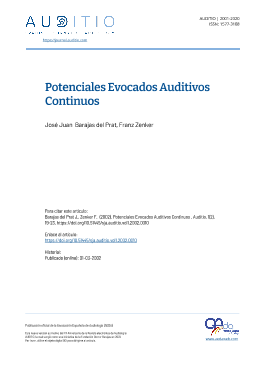Steady-state Auditory Evoked Potentials
Review
DOI:
https://doi.org/10.51445/sja.auditio.vol1.2002.0010Keywords:
steady-state evoke potentials, frequency specific, electrophysiological audiometry, hearing screeningAbstract
The early diagnosis of hearing loss should be carried out early in view of the implications that the lack of auditory stimulation has on the development of language and speech. Up to six months, behavioral audiometries are not reliable, so at these ages, newborns are evaluated using Otoacoustic Emissions (OAE) and Auditory Brainstem Responses (ABR). However, these techniques are not capable of deriving selective information from the cochlear partition. Auditory Steady-state Responses (ASSR) are a periodic evoked brain response in time whose frequency remains constant in amplitude and phase. For audiometric purposes ASSRs have several advantages over ABRs. First, through statistical procedures, the presence of response is determined, increasing the reliability and validity of the technique. Second, ASSR allow the use of frequency-specific tones. Third, ASSR allow the derivation of specific information on the frequency of the cochlear partition. This article reviews the principles and foundations of this electrophysiological technique.
Downloads
Visibility and Altmetrics
Metrics
Global Statistics ℹ️
|
2345
Views
|
2841
Downloads
|
|
5186
Total
|
|
References
National Institute of Health. (1993) Early identification of hearing impairment in infants and young children. NIH Consensus Statement 1993 March 1-3 11(1), 1-24.
Durieux-Smith, A., Picton, T., Edwards, C., Goodman, J.T., y Mac Murray, B. (1985). The Cri-O-Gram in the NIUC: An evaluation based on brainstem electric response audiometry. Ear Her. 6, 20-24. https://doi.org/10.1097/00003446-198501000-00006
White, K. R., and Behrens, T.R. (1983). The Rhode Island hearing assessment project: implication for universal newborn hearing screening. Sem. Hear 14, 1-119.
Regan, M.P., and Regan, D. (1989). Objetive investigation of visual function using a non-destructive zoom-FFT technique for evoked potential analysis. Can J Neurol Sci 16, 168-179. https://doi.org/10.1017/S0317167100028845
Regan, D. (1982). Comparison of transiet and steady-state methods. Ann N.Y. Acad. Sci. 388, 45-71. https://doi.org/10.1111/j.1749-6632.1982.tb50784.x
Galambos, R., Making, S., and Talmachoff, P.J. (1981). A 40 Hz auditory potential recorded from the human scalp. Proc Natl Acad Sci USA, 78, 2643-2647. https://doi.org/10.1073/pnas.78.4.2643
Stapells, D.R., Linden, D., Suffield, J.B., Hamel, G., and Picton, T.W. (1984). Human auditory steady state potentials. Era Hear. 5, 105-113. https://doi.org/10.1097/00003446-198403000-00009
Stapells, D.R., Galambos, R., Costello, J.A., and Makeg, S. (1988). In consistency of auditory middle latency and steady state responses in infants. Electroencephalogr. Clin. Neurophysiol. 71, 289-295. https://doi.org/10.1016/0168-5597(88)90029-9
Rayleigh, Lord. (1880). On the resultant of a large number of vibrations of the same pithc and of arbitrary phase. Philosophical Magazine;10:73-78. https://doi.org/10.1080/14786448008626893
Stapells DR, Makeig S, Galambos R. (1987). Auditory steady-state responses: threshold prediction using phase coherence. Electroenceph Clin Neurophysiol 1987;67:260-270. Strasburger H. The analysis of steady-state evoked potentials revisted. Clin Vision Sci;1:245-256. https://doi.org/10.1016/0013-4694(87)90024-1
Hotelling H. (1931). The generalization of Student's ratio. Ann Math Statist;2:360-378. https://doi.org/10.1214/aoms/1177732979
Picton TW, Vajsar J, Rodriguez R, Campbell KB. (1987). Reliability estimates for steady state evoked potentials. Electroenceph Clin Neurophysiol 1987;68:119-131. https://doi.org/10.1016/0168-5597(87)90039-6
Schuster A. (1898). On the investigation of hidden periodicities with application to a supposed 26 day period of meteorological phenomena. Terrestrial Magnetism and Atmospheric Electricity 1898;3:13-41. https://doi.org/10.1029/TM003i001p00013
Fisher NI. (1993). Statical analysis of circular data. Cambridge: Cambridge University Press.
Fisher RA. (1929). Test of significance in harmonic analysis. Prco Roy Soc London Ser A; 125:54-59. https://doi.org/10.1098/rspa.1929.0151
Zurek PM. (1992). Detectability of transiet and sinusoidal otoacoustic emissions. Ear Hear 1992; 12:307-310. https://doi.org/10.1097/00003446-199210000-00008
Rance G, Rickards FW, Cohen LT, De Vidi S, Clark GM. (1995). The automated prediction of hearing thresholds in sleeping suvjects using auditory steady-state evoked potentials. Ear Her;16:499-507. https://doi.org/10.1097/00003446-199510000-00006

Published
Versions
- 2021-09-15 (2)
- 2002-03-01 (1)
How to Cite
Issue
Section
License
Copyright (c) 2002 Auditio

This work is licensed under a Creative Commons Attribution 3.0 Unported License.
All articles will be published under the open Creative Commons Attribution (CC-BY) license. This license allows others to share and adapt the content, even for commercial purposes, as long as appropriate credit is given to the authors and the journal. By submitting their manuscript, authors retain copyright but grant the journal the right to make the first publication under this license.
More information about this license is available at: https://creativecommons.org/licenses/by/4.0/
Articles published between 2001 and 2020
The texts published in this journal in the section "AUDITIO 2001-2020" are subject - unless otherwise indicated - to a Creative Commons Attribution 3.0 Spain license. You can copy, distribute, communicate them publicly, make derivative works and commercial uses provided that you acknowledge the credits of the works (authorship, name of the journal, publishing institution) in the manner specified by the authors or by the journal. The full license can be consulted at http://creativecommons.org/licenses/by/3.0/es/deed.es.









